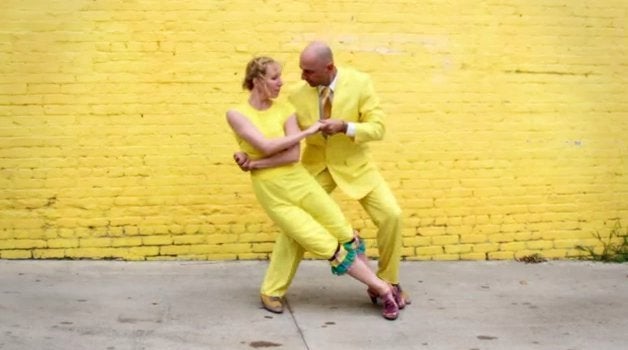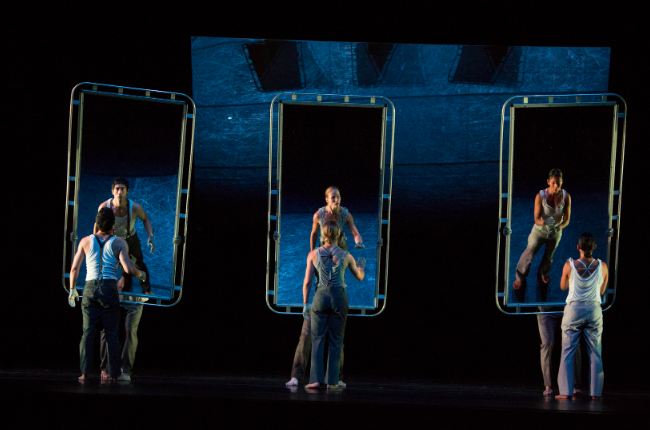
If you have a boyfriend who's "not sure about this whole dance thing," you take him to see Pilobolus. He may even know the company already, from their performances at the Oscars and in car commercials. Everybody finds something to like about this eminently likable group. At its best, Pilobolus presents eye-poppingly gymnastic works that effectively blend high- and low-concept dance. At its worst, it gets lost in its own tricks, preoccupied with the wham-boom-pow side of its signature formula, and just looks like a very good college dance troupe. (To be fair, it did start out as a college dance troupe, founded by four Dartmouth students in 1971.)
Pilobolus has a popular season at the Joyce Theater every summer, and each year it presents a few new works along with a selection of its tried-and-true hits. This year the two premieres on its first program are collaborations with two very different choreographers: Sidi Larbi Cherkaoui, a European darling who made the darkly sensual Orbo Novo for Cedar Lake Contemporary Ballet in 2009; and Trish Sie, the brain behind many of the band OK Go's YouTube-sensation music videos (as she identifies them in her bio, they include the "treadmill video" and the "dog video"). They're two artists who perfectly represent the company's range -- from the avant garde to the poppiest of pop culture.
Cherkaoui's contribution, Automaton (co-created by Pilobolus associate artistic director Renée Jaworski), is a pas de neuf for six dancers and three double-sided mirrors, with another enormous mirror hung at an angle from the back of the stage. It riffs on the funhouse quality that occurs when reflections are reflected in reflections, when a cast of a few can look like a cast of dozens. The dancers start out moving robotically, locking into positions and then reverberating from the force of the lock, sometimes assembling to form living machines. At one point Jun Kuribayashi is imprisoned inside the three mirrors, which the other dancers rotate around him as if they're performing a magician's trick. And, voila! They are: It's Eriko Jimbo, not Jun, who emerges from the middle. Gradually, the dancers' movements soften and become more fluid, more deliberately human.

Pilobolus in Automaton. Photo by Oriel Pe'er.
There are a few moments in Automaton where the dancing makes as much of an impression as the prop play -- as when two dancers hook each other by the ankles, Barrel of Monkeys style, and that one point of connection inspires a stream of idiosyncratic partnering. But as a whole the piece feels like a series of unfinished thoughts.
If you've seen OK Go's music video for their song "Skyscrapers," then you've essentially seen the second premiere, also called Skyscrapers: Sie, who choreographed and performed in the video, set its choreography on Pilobolus (assisted by Paula Salhany and Jaworski) with what seems like very few alterations. The film version features Sie and Moti Buchboot tangoing across sets in a variety of vivid hues, their outfits changing to coordinate with each color. The trick to dancing this live, of course, is doing the costume changes in real time, which is where most of the appeal of Pilobolus' Skyscrapers lies. Performed by three couples instead of one -- to allow each a bit of offstage time for all that stripping and re-dressing -- it's a cute party trick. But the Pilobolus dancers, extraordinary as they are, aren't tango experts like Sie. The video is slick, sophisticated, suspenseful even; the onstage version is clumsy fun.
Pulled from the well-stocked Pilobolus archives to round out the program are Gnomen, Duet and Megawatt. Gnomen, for four men, and Duet, for two women, are related: Both feel like obscure tribal rituals, one an exploration of brotherhood, the other of sisterhood. And both mine the infinite partnering possibilities of supremely strong dancers. Gnomen's opening is particularly unforgettable: The four men roll in together, somehow, as a single man-ball. Duet's experiments with counterbalance are equally boggling: Occasionally it's hard to tell which of the dancers' points of connection is the weight-bearing one, so seamlessly does everything flow. These works are old-school Pilobolus -- no props, no grand conceits, just bodies doing things we've never seen bodies do before.
Set to a frat boy's playlist of songs by Primus, Radiohead and Squarepusher, Megawatt, which closes the program, is less a dance than a series of creative seizures. Its seven cast members spend most of their time flailing, jerking and twitching as if -- you guessed it -- being electrocuted. (Mercifully, the floor is padded.) Eventually all that shaking becomes visually exhausting.
But as pure adrenaline rushes go, Megawatt is first-rate. Towards the end, pairs of dancers begin hurling themselves into rapid somersaults, one rolling forward as the other rolls back and then vice versa, compelled into velocity by the huge, hammering bass beat. It's Pilobolus' equivalent of head-banging, and it's irresistible. You, and your boyfriend, leave the theater fist-pumping.
--------
A former dancer and choreographer, Margaret Fuhrer is an associate editor at "Dance Spirit" and "Pointe" magazines.